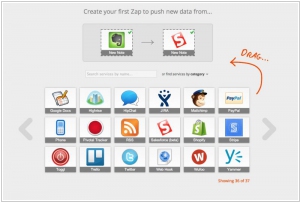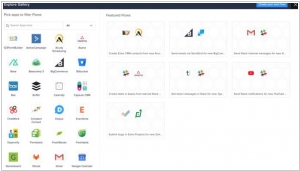Zapier vs Zoho Flow
May 26, 2023 | Author: Michael Stromann
Zapier and Zoho Flow are both popular automation platforms that enable users to connect and automate workflows between different apps and services. Zapier is known for its wide range of app integrations, offering connectivity with over 3,000 apps. It provides a user-friendly interface and a vast library of pre-built integrations called "Zaps" that allow users to create automated workflows without coding knowledge. Zoho Flow, on the other hand, is a part of the Zoho suite of products and focuses on integrating Zoho apps seamlessly. It offers a robust set of integrations specifically tailored to the Zoho ecosystem, including Zoho CRM, Zoho Books, Zoho Creator, and more. Zoho Flow provides a user-friendly visual builder, and users can create customized workflows, known as "Flows," to automate tasks across Zoho apps.
See also: Top 10 Cloud Integration software
See also: Top 10 Cloud Integration software
Zapier vs Zoho Flow in our news:
2023. Zapier launches Canvas, an AI-powered flowchart tool
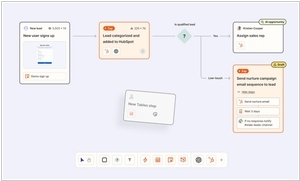
Zapier has unveiled Canvas, a innovative tool designed to assist users in planning and visualizing their crucial business processes. The tool combines intuitive visual diagramming features with AI capabilities to aid users in transforming their processes into Zapier-based automations. Canvas serves as a comprehensive platform where users can map out their processes from start to finish, and even modify the elements connected to Zapier directly within the interface. Notably, Zapier envisions expanding Canvas's functionality to allow users to edit any components, whether or not they are linked to Zapier, directly within the tool. In essence, Canvas functions as both a basic flowchart diagramming tool for process documentation and as an interface for editing the connected components. Additionally, Zapier has made Tables, its automation-focused database service, available to all users, further enhancing its automation capabilities.
2021. Zapier buys no-code-focused Makerpad
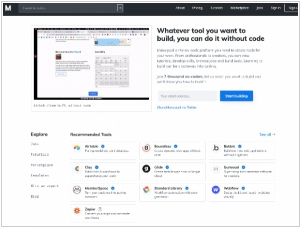
Zapier, a renowned no-code automation tool, has acquired Makerpad, an educational service and community focused on no-code development. The no-code sector, along with its related field of low-code development, has been vibrant in recent times. The low-code market has witnessed significant funding rounds, with some companies adopting low-code tools to expedite internal software development. In the no-code realm, Zapier stands as a notable success with its impressive revenue figures reaching nine digits.
2018. Zoho launched app integration platform Zoho Flow
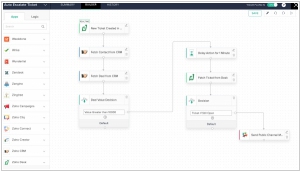
Zoho Flow is an innovative integration platform designed to seamlessly connect all of your cloud applications. With Zoho Flow, you can effortlessly create workflows, known as "Flows," that establish connections between various cloud apps without the need for coding. Whether you're transferring information between apps or executing complex business processes, Zoho Flow empowers you to automate a wide range of tasks. The process of creating a Flow is straightforward: set a trigger, add a sequence of actions, switch it on, and you're good to go! For instance, you can create a Flow that activates when a ticket is submitted to your help desk, automatically updates or adds leads in your CRM system, and sends an update to your team chat application. Zoho Flow simplifies and streamlines your app integration process, enabling enhanced productivity and efficiency.
2017. Zapier added shared folders for teams
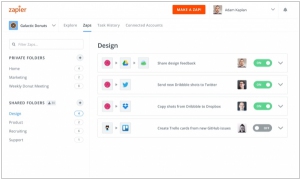
The cloud app integration service Zapier has introduced shared folders, enabling teams to collaborate and automate tasks collectively. These shared folders facilitate access to a shared collection of Zaps, allowing teammates to collaborate and construct more robust workflows. With an individual Zapier account, users can create automated workflows called Zaps that connect multiple apps. However, until now, it was not possible to share these innovative workflows with colleagues. Shared folders eliminate this limitation by enabling collaboration. Anyone with access to a shared folder can modify and enhance the Zaps within it, or even duplicate them for their own utilization. Furthermore, we have incorporated an option to share accounts for other tools, such as Dropbox, Pipedrive, and Typeform. This eliminates the need to create separate logins for each team member.
2017. Zapier launched team accounts
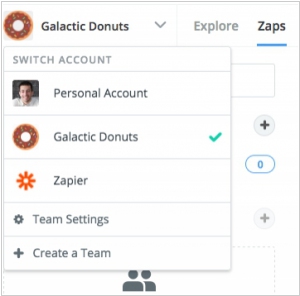
Zapier, a platform that specializes in connecting applications and automating workflows, has introduced a new offering called Zapier for Teams. This plan, priced at $250 per month, complements Zapier's existing free and $20/month tiers and incorporates several collaborative features into the service. With Zapier for Teams, businesses can now grant their employees access to Zapier while managing a single consolidated bill. The implementation of this plan also enhances security measures by allowing companies to easily add and remove user accounts as needed. Previously, under Zapier's previous pricing tiers, employees would often resort to sharing passwords, which was far from an ideal solution. With Zapier for Teams, companies can foster improved security practices and enjoy the benefits of streamlined collaboration within their organization.

